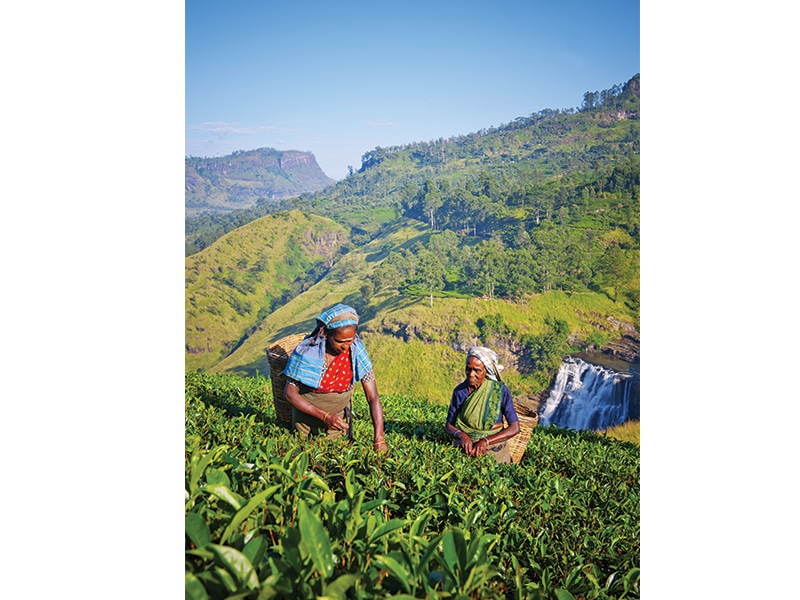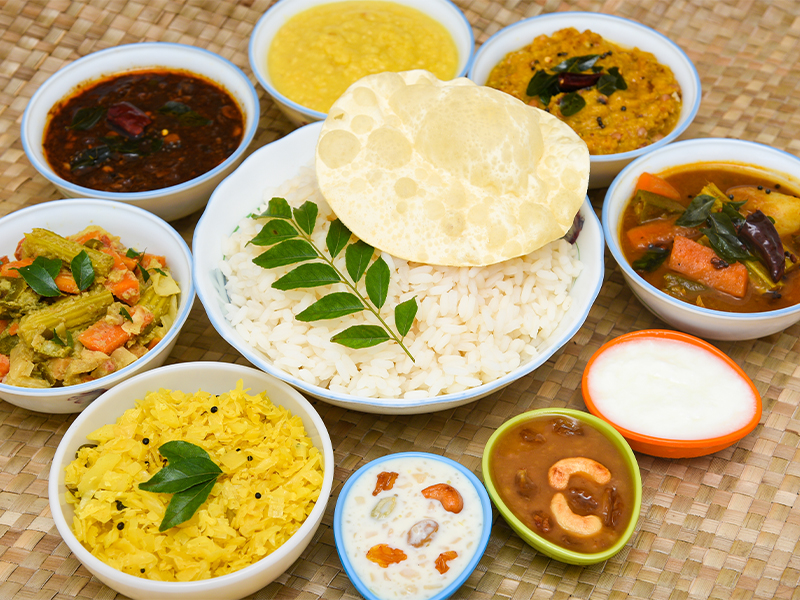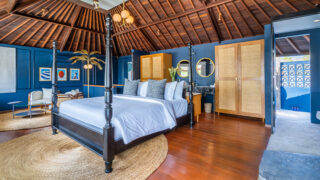Appearing on the map like a teardrop in the ocean off the Indian coastline, Sri Lanka is a fabulous getaway for everyone from families to groups of friends, couples and solo travellers. You can stick to the much-loved coastline, including the likes of Galle and Unawatuna; or go inland to explore the tea country, the mountains near Kandy, a range of impressive historical sights and more. Before you head off on your holiday to Sri Lanka, however, do a bit of research by reading our guide!
The basics
Population: Around 22 million
Capital: Sri Jayawardenapura-Kotte
Religion: Approximately 70% of Sri Lankans are Theravada Buddhists, and 11% are Hindu
Emergency numbers: 110 (ambulance/fire, Colombo), 119 (police)

Fact file
- Sri Lanka became famous for tea only after its coffee fields were wiped out by leaf blight in the 1870s.
- The Sri Lankan flag is the only one in the world to recognise different religious groups. The yellow border and pipul leaves symbolise Buddhism, while the green and saffron bands represent Muslim and Hindu communities.
- The world’s first female prime minister was Sirimavo Bandaranaike of Sri Lanka.
- A footprint found on the sacred mountain, Sri Pada (Adam’s Peak), is believed by Buddhists to belong to Buddha, by Muslims to Adam, by Christians to St Thomas and by Hindus to Lord Shiva.
- Waterfalls power much of Sri Lanka’s electricity.
- Cricket is the most popular sport but the national sport is volleyball.
Key dates
- Poya Days: These are Buddhist public holidays occurring every full moon day. Shops and businesses generally close for the day, and meat and alcohol sales are widely prohibited.
- 13-14 April: Sinhalese New Year. Celebrated not only by the Sinhalese people but by most Sri Lankans. Many workers return to their home villages where they set off firecrackers and partake in feasts.
Hot spots and itineraries
Popular destinations include Colombo, Sigiriya, Unawatuna, Kandy, Anuradhapura, Polonnaruwa, Galle, Hikkaduwa, Nuwara Eliya, Adam’s Peak, and Yala National Park. Among the eight World Heritage Sites are the Golden Temple of Dambulla and the ancient cities of Polonnaruwa and Sigiriya.
Some itinerary ideas
- Go Coastal: Negombo – Colombo – Hikkaduwa – Galle – Mirissa
- Tea & Temples: Colombo – Kandy – Nuwara Eliya
- Cultural Triangle: Kandy – Sigiriya – Polonnaruwa – Anuradhapura
A bit about the beaches
Sri Lanka is surrounded entirely by the Indian Ocean, so it’s no great surprise that every compass point around the island boasts a beautiful beach or two. The best time to visit for surfing or sunbathing is August to October, before the start of the monsoon season. Here’s our compass-point guide to where to go!
North
Situated in the middle of the island’s northeast coast, Trincomalee offers beautiful sandy beaches with palm trees and blue waters. You can visit Nilaveli Beach and try your hand at fishing, book a whale-watching tour, or take a short boat ride to Pigeon Island, a popular snorkelling spot. Also nearby is Coral Island, boasting a gorgeous reef with tropical fish and marine life. Windsurfing aficionados will want to head a little further south to Uppuveli Beach for some board-and-sail action.
South
Located close to the historic city of Galle along the southwest coast, Hikkaduwa Beach is firmly on the tourist trail and for good reason. Beat the heat with a leisurely snorkel or a full-blown dive at Hikkaduwa Coral Reef, or stay dry and enjoy the view from a glass-bottomed boat. There’s a vibrant nightlife scene in town, with rows of restaurants and bars lining the shore. Further south is Mirissa Beach, a laid-back coastal community, where you can surf, jet ski or kite surf by day, and admire the stunning sunsets by night, with a few drinks and some fresh seafood cooked up in the restaurants along the beach.
East
If you’re keen to catch some waves, Arugam Bay is the place to go. Located on the southeast corner of the island, this is arguably Sri Lanka’s best break. Or, if boards aren’t your thing, you can just enjoy the sun and relax at one of the many bars along the beach. End the day with a barbecue seafood feast beneath the palms.
West
Dropping by the beach town of Negombo on the west coast is a breeze, as it’s located less than 30 minutes from Sri Lanka’s international airport – maybe one final seaside stop before heading back home? Resorts line the beach, so there are plenty of rooms with a view. The sea can be a little rough, so, if you’re keen on water sports, you can travel south to Negombo Lagoon for banana-boating, water skiing, kayaking and jet-skiing.
Staying safe and healthy
Drink bottled or boiled water, or carbonated drinks – avoid tap water, fountains and ice cubes. Street food can be delicious but it’s best to avoid uncooked food (especially shellfish) and ice cream vendors. The sun can be full-on in Sri Lanka: keep your fluids up! (No, not just beer.)
Cultural things
While you’re there, please don’t …
- Use your left hand when shaking hands, handing money and small objects, and so on. Happily, Sri Lankans are fairly forgiving of tourists when they mess this up!
- Take photos of guards, police or sensitive locations.
Before you go, read …
- Running in the Family by Michael Ondaatje – a fictionalised account of the author’s return to his native Sri Lanka in the late 1970s.
- Chinaman: The Legend of Pradeep Mathew by Shehan Karunatilaka – though you have to be mad about cricket to enjoy it, this Singapore-based Sri Lankan’s first novel is a stunner.
Before you go, watch …
- A Peck on the Cheek – a Tamil drama in which young Amudha learns she is adopted and sets out to find her biological mother.
- From Dust – a documentary that looks at the government’s response to a natural disaster, in this case, the Asian tsunami of 2004.
They said it
“The island of Ceylon (Sri Lanka) is a small universe; it contains as many variations of culture, scenery and climate as some countries a dozen times its size.” – Sir Arthur C. Clarke, science fiction author and resident of Sri Lanka for over 50 years, from 1956 until his death in 2008
“Wisdom can be found travelling.” – Sri Lankan proverb
“It’s time for Sri Lankan to heal the wounds and unite without regard for religious and ethnic identity.” – Ban Ki-moon, former Secretary-General of the United Nations, speaking in 2009 at the end of the civil war

Important questions
Do I need a visa?
Citizens of Singapore, Seychelles and the Maldives do no need a visa to enter Sri Lanka. The status for other countries varies; in 2023/24, a handful of other countries were granted visa-free entry for a time. However, most nationalities do require a visa; you can apply for a short-stay visa online at eta.gov.lk/slvisa. Tourist visas on arrival are available.
What time is it in Sri Lanka?
Sri Lanka is 5.5 hours ahead of GMT, 2.5 hours behind Singapore and 4.5 hours behind Sydney.
What’s the money situation?
The official currency of Sri Lanka is the Sri Lankan rupee (LKR). Most major banks will change US dollars, Euro and GBP. Visa and MasterCard are the commonly accepted credit cards at top end hotels and restaurants. There are ATMs in major cities but it’s best to have cash for small purchases or if you’re heading out of town.

When’s the best time to visit?
The best time to travel to the western and southern coasts and hill country is between December and March. May to September is regarded as prime time to see the eastern coastlines.
What’s the lingo?
The official languages of Sri Lanka are Sinhala and Tamil; many Sri Lankans also speak English. Here are some Sinhalese phrases to get you started:
- Hello: Ayubowan
- What is your name? Oya geh nàma monadha?
- My name is __: Mageh nàma __
- How much? Keeyah the?
- Thank you: Bohomus isthuthi
- Yes: Ohw
- No, thank you: Nah isthuti
Last but not least
Is there anything I should know about meeting the locals?
Try to greet people by saying “ayubowan”, with your hands pressed together at chest level. Light handshakes are common among the younger generation.
What’s a must-try dish?
Curry and rice; variations include beetroot, jackfruit, daal, fish, chicken and many others.
What should I buy as a souvenir?
Traditional wooden devil masks, tea, packets of spices, and also Ayurvedic beauty products.

For a tropical summer vacation
Close to the historic port of Galle, The Fortress blends the colonial architecture of the Dutch and Portuguese eras. Its 53 rooms include two residential suites and come with private courtyards or balconies, and with sea or garden views. There are three restaurants: Salty Snapper overlooking the ocean and serving the country’s famed seafood dishes; White Restaurant offering everything from local cuisine to wood-fired pizzas, and Duo for fine dining. There’s also the T Lounge, dedicated to serving Sri Lanka’s famous tea.

The on-site Spa Naturel offers a range of international and Ayurvedic therapies and beauty treatments, while other leisure facilities include a free-flowing pool, fully equipped gymnasium and yoga pavilion.
For a family adventure

Holidays with teenagers need a little twist – something really exciting to engage their imaginations – and the team from luxury travel operator Scott Dunn is sure that Sri Lanka has it all. Tropical beaches, waterfalls, incredible wildlife, tea plantations and fabulous food make it a perfect destination that the whole family can enjoy.
Each Scott Dunn itinerary is completely tailor-made. It acknowledges that teens might not be great fans of endless ancient sites and temples! Instead, the “Sri Lanka for Teenagers” itinerary is more about seeing local life and uncovering hidden gems. There are lots of activities to keep them occupied – plus beach time too! Spend your days on the lookout for elusive leopards in Wilpattu National Park or learning the art of haggling in the local markets with your private driver guide, before retreating to a luxury boutique hotel for some chill-out time.
Read more in our Travel section!






